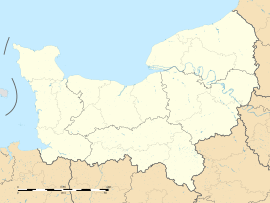Saint-Germain-Langot facts for kids
Quick facts for kids
Saint-Germain-Langot
|
|
|---|---|
| Country | France |
| Region | Normandy |
| Department | Calvados |
| Arrondissement | Caen |
| Canton | Falaise-Nord |
| Intercommunality | Pays de Falaise |
| Area
1
|
10.35 km2 (4.00 sq mi) |
| Population
(1999)
|
271 |
| • Density | 26.18/km2 (67.82/sq mi) |
| Time zone | UTC+01:00 (CET) |
| • Summer (DST) | UTC+02:00 (CEST) |
| INSEE/Postal code |
14588 /14700
|
| Elevation | 135–239 m (443–784 ft) (avg. 180 m or 590 ft) |
| 1 French Land Register data, which excludes lakes, ponds, glaciers > 1 km2 (0.386 sq mi or 247 acres) and river estuaries. | |
Saint-Germain-Langot is a small place in France. It is known as a commune, which is like a local town or village area. You can find it in the northwest part of France.
This commune is located in the Calvados department. A department is similar to a county in some other countries. Calvados is part of the region called Basse-Normandie.
Contents
Where is Saint-Germain-Langot?
Saint-Germain-Langot is in the region of Basse-Normandie. This area is in the northwestern part of France. It is also part of the Calvados department.
The commune covers an area of about 10.35 square kilometers. This is roughly 4 square miles. It is a fairly small area.
The land in Saint-Germain-Langot is not completely flat. Its elevation, or height above sea level, changes. The lowest point is 135 meters (about 443 feet). The highest point is 239 meters (about 784 feet). The average elevation is around 180 meters (about 590 feet).
How many people live there?
In 1999, about 271 people lived in Saint-Germain-Langot. This makes it a very small community. The number of people living in a commune can change over time.
Who runs Saint-Germain-Langot?
Like many places, Saint-Germain-Langot has a local leader. This leader is called the mayor. The mayor helps manage the commune.
From 2008 to 2014, the mayor was Régis Hie. The mayor works with a local council. They make decisions for the people living in the commune.
Saint-Germain-Langot is also part of a group called "Pays de Falaise." This is an intercommunality. It means several communes work together. They share services and projects. This helps them manage things like waste or public transport more easily.
See also
 In Spanish: Saint-Germain-Langot para niños
In Spanish: Saint-Germain-Langot para niños



